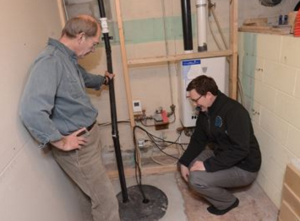Focus on reducing losses associated with sump pumps
0 October 19, 2015 at 3:58 pm by Glenn McGillivray Hundreds of thousands of homes across Canada have sump pump systems, designed to collect water from the weeping tiles and safely eject it away from the foundation. These systems are a major source of property damage claims for Canadian personal lines writers because when there is a failure, a basement will flood, often extensively.
Hundreds of thousands of homes across Canada have sump pump systems, designed to collect water from the weeping tiles and safely eject it away from the foundation. These systems are a major source of property damage claims for Canadian personal lines writers because when there is a failure, a basement will flood, often extensively.
Many of the problems associated with sump pump system failure can easily be addressed through two avenues, and ICLR strongly recommends that homeowners with sump pump systems address both in order to prevent a catastrophic basement flooding event.
The first avenue is ensuring that a back up pump is plumbed into the system and the second is to ensure that the sump system has an alternative source of power to run it should the main power source be unavailable for any length of time. (I’m reminded of the story of an independent claims adjuster who had to hand-bail his sump pit for 36 straight hours during a power failure to prevent his basement from flooding.)
If a home’s sump pump only occasionally runs, perhaps only in spring or only during a heavy rainfall event, it is recommended that redundancy be installed via a second, backup pump. The second pump can be raised on a block or some other form of riser to ensure that it does not turn on simultaneously with the primary pump. Ideally, the backup pump should be plugged directly (i.e. no extension cord) into a wall outlet that is on a circuit that is separate from the primary pump.
If a home’s sump pump runs often – or all the time – it is recommended that double-redundancy be installed via a second, backup pump and a third emergency pump. Again, it is recommended to raise the second pump off the floor of the sump pit so it will only turn on when needed and won’t always run simultaneously with the primary pump. It is also recommended that the backup pump be plugged directly into an outlet that is on its own circuit. As for the emergency (third) pump, one may consider installing a pump that operates off the home’s potable water supply. When considering such a product, it is imperative that the home have the proper, minimum water pressure (PSI) as recommended in the manufacturer’s instructions. These pumps will likely not work properly in some rural areas or where a home is on a well system, due to low PSI.
As for backup power, the first option is to install an emergency generator that runs on gasoline, diesel, natural gas or some other fuel. Generators can, however, be noisy, dirty and dangerous, and require a steady supply of fuel (something that may be difficult during a prolonged power outage or large civic emergency). A second option is to install a battery backup power system that uses a deep cycle marine battery. These systems, widely available at hardware and home renovation stores, will run a sump system for several hours, though batteries do have to be replaced every few years. A third option is the potable water-driven pump noted above, with caveats pertaining to the home’s ability to run such a pump (as noted).
Along with these two main ways of preventing sump pump failure, it is also recommended that the homeowner use a sump pump alarm system to be alerted should water in the sump pit rise to a higher-than-usual level. An alternative to an audible alarm, which is only helpful if the homeowner is home when it goes off, is a wireless Internet alarm system that will send a text message to a number of wireless devices advising of an impending problem with water levels in the sump pit. These devices are helpful, as the homeowner needn’t be home to receive a warning.
Being reasonably complicated, mechanical/electrical devices, sump pump systems can fail, particularly when they aren’t inspected and maintained on a regular basis. Following some fairly straightforward recommendations, like installing backup pumps and backup power, can prevent much of the damage caused by failed sump systems.
Many of these recommendations and maintenance tips can be found in the ICLR booklet ‘Focus on: Sump pump systems’, a publication that explains what sump pump systems are, what they do, how they can fail, and how they should be tested and maintained. The booklet also provides advice on what to consider when having a sump pump system installed, or when replacing an old pump.
In the meantime, ICLR will continue to work to have Canadian building codes changed so they require the use of backup sump pumps and backup power in all new builds with sump systems.
Note: By submitting your comments you acknowledge that insBlogs has the right to reproduce, broadcast and publicize those comments or any part thereof in any manner whatsoever. Please note that due to the volume of e-mails we receive, not all comments will be published and those that are published will not be edited. However, all will be carefully read, considered and appreciated.

Leave a Reply